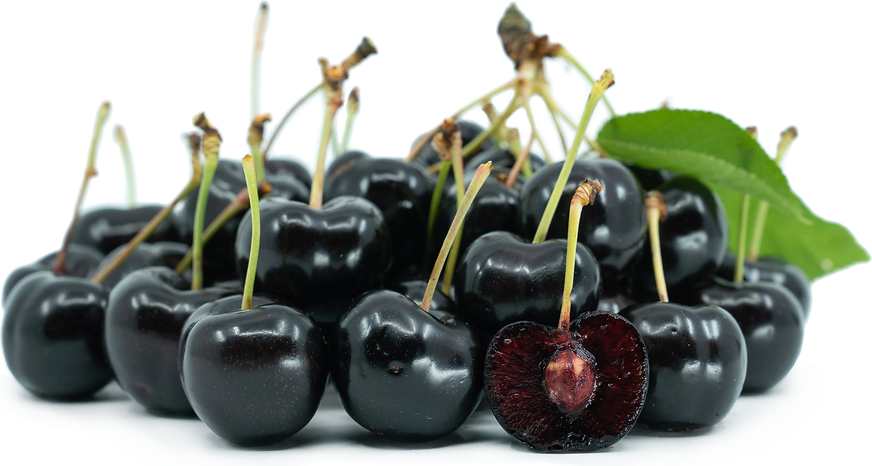


Van Cherries
Estimated Inventory, lb : 0
Description/Taste
Van cherries are a medium to large varietal, averaging 2 to 3 centimeters in diameter, and have a blocky, round to cordate shape with a distinct, short, and fibrous green stem. The fruits bear curved shoulders that slightly taper at the base, and the skin is smooth, taut, and glossy with crimson to dark red, almost black hues. Underneath the surface, the flesh is firm with an aqueous, tender, and succulent consistency, encasing a small central tan pit that is inedible and should be discarded. Van cherries range from 18 to 22 Brix, a measurement of the sugar content in the flesh, and contain low acidity, contributing to a bright, sweet, subtly tart, and tangy flavor.
Seasons/Availability
Van cherries are available in the late spring through early summer.
Current Facts
Van cherries, botanically classified as Prunus avium, are a variety of sweet cherry belonging to the Rosaceae family. The mid-season cultivar grows in large clusters on trees that can reach up to four meters in height and is a cold-tolerant cherry favored for its high yields. Van cherries were developed in Canada in the mid 20th century and were selected for their sweet flavor, hardiness, crack resistance, and dark flesh. The trees also bear fruit in 4 to 5 years, which is earlier than other popular cultivars. Van cherries were named after pomologist J.R. Van Haarlem and are a Canadian cultivar primarily grown to breed other cherry varieties, including rainier cherries. The cherries are also cultivated on a small scale for fresh eating and are widely favored in British Columbia and the Pacific Northwest for their firm flesh and sweet flavor.
Nutritional Value
Van cherries contain anthocyanins, the red and purple pigments found within the skin and flesh that have antioxidant-like properties to reduce inflammation and protect the cells against free radical damage. The fruits are also a source of vitamin C to strengthen the immune system, vitamin A to maintain healthy organ functioning, potassium to balance fluid levels within the body, and contain other amounts of iron, calcium, and magnesium.
Applications
Van cherries have a sweet-tart flavor well suited for fresh eating or incorporating into sweet and savory cooked preparations. When fresh, the fruits can be consumed straight, out of hand, discarding the seed, or they can be utilized as a garnish over desserts and ice cream. Van cherries can also be sliced and tossed into fruit bowls, mixed into green salads, chopped into salsa, or blended into smoothies. In addition to raw preparations, Van cherries can be simmered into jams, compotes, and jellies, or infused into syrups for pie fillings, tarts, cocktails, and ice cream. The cherries can also be baked into bread, scones, cakes, and muffins, stuffed into roasted meats, or cooked into a barbeque sauce and poured over smoked main dishes. Van cherries pair well with honey, vanilla, dark chocolate, caramel, nuts such as almonds, hazelnuts, and pistachios, fennel, arugula, creamy or salty cheeses, and meats including poultry, duck, and pork. Whole, unwashed Van cherries will keep up to one week when stored between paper towels in the coldest part of the refrigerator. The cherries can also be frozen, canned, or dried for extended use.
Ethnic/Cultural Info
Van cherries were the first variety of cherry bred at the Summerland Research and Development Center in the Okanagan Valley of British Columbia. The center was the 14th research station established in Canada and was originally launched in 1914 with an early focus on livestock feed and fertilizers. In the 1930s, the center shifted to fruit tree breeding, leading to the creation of the Van cherry in 1942. Scientists sought to create a sweet, black cherry variety that showed improved resistance to cracking, a quality flavor, and developed a firm texture. They also persevered to create a variety that could be used to pollinate popular cultivars such as lambert, napoleon, and bing cherries. Since their release, Van cherries have remained one of the most important pollinizer varieties cultivated in British Columbia. In the Okanagan Valley, cherry production has become so intertwined with the lifeblood of the local communities that the world’s largest cherry pie was also baked in the small town of Oliver in 1992. The pie weighed over 37,000 pounds with a diameter of 6 meters and was made with 64,000 cups of cherries, 276 eggs, 1120 cups of flour, and 122,000 tablespoons of sugar. The pie was fed to over 3,000 people and has remained a favored memory of the Okanagan cherry community.
Geography/History
Van cherries were developed by AJ Mann at the Summerland Research and Development Center, located in the Okanagan Valley of British Columbia. The variety was created from an open-pollinated cross of the empress eugenie cherry in 1936 and was selected for commercial cultivation in 1942. Van cherries were released to the public in 1944 and were quickly spread worldwide, cultivated in Australia, Germany, and the United States. Despite the initial success of Van cherries, the cultivar requires another variety for pollination, causing the variety to fade from popularity in the 1960s in favor of self-fertile cherry cultivars. Today Van cherries are primarily grown in orchards as a pollinizer for other cherry varieties. The fruits are also cultivated on a small scale in temperate climates through select growers and home gardeners for fresh use. Van cherries are found in Canada, the United States, Europe, Australia, and New Zealand through local markets and specialty distributors.
Recipe Ideas
Recipes that include Van Cherries. One
Podcast




